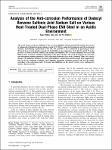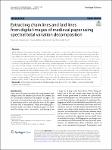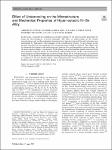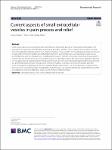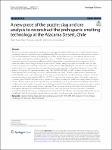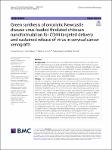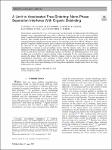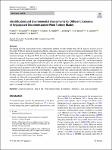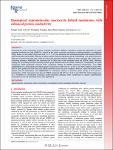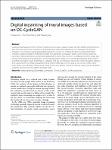Search
Author
- Osman, Ahmed I. (5)
- Daqing, Ma (3)
- Jorgensen, Ed (3)
- Li, Yan (3)
- next >
Subject
- kinh tế (26)
- Economics (12)
- programming (10)
- XRD (10)
- next >
Date issued
- 2020 - 2025 (2129)
- 2010 - 2019 (129)
- 2000 - 2009 (9)
- 1999 - 1999 (1)
Has File(s)
Search Results
This work focuses on the investigation of the corrosion inhibition of heat-treated EN8 steel in the presence of sodium salt of dodecyl benzene sulfonic acid in 0.5 M H2SO4 using the Gravimetric and Electrochemical methods. Austenitizing is performed at 700, 750, 790, and 900 °C for 2 h followed by quenching in water. When the heat-treated metal is exposed to 0.5 M H2SO4 at the temperature of 30, 40, 50, and 60 °C in the presence of dodecyl benzene sulfonic acid sodium salt inhibitor, the corrosion inhibition increased with different heat treatment conditions depending on the phase change. This work investigates the activation and adsorption isotherm parameters. The adsorption isotherms were used to estimate Gibb's free energy change. The inhibition efficiency increased with inhibito... |
Medieval paper, a handmade product, is made with a mould which leaves an indelible imprint on the sheet of paper. This imprint includes chain lines, laid lines and watermarks which are often visible on the sheet. Extracting these features allows the identification of the paper stock and gives information about the chronology, localisation and movement of manuscripts and people. Most computational work for feature extraction of paper analysis has so far focused on radiography or transmitted light images. While these imaging methods provide clear visualisation of the features of interest, they are expensive and time consuming in their acquisition and not feasible for smaller institutions. However, reflected light images of medieval paper manuscripts are abundant and possibly cheaper i... |
Effect of Undercooling on the Microstructure and Mechanical Properties of Hyper-eutectic Ni–Sn Alloy In this study, container-less solidification of hyper-eutectic Ni–Sn alloy has been performed by using the electromagnetic levitation technique. The effect of undercooling on the formed microstructure and on the mechanical properties have been investigated. Growth velocities were determined by high-speed video-imaging of the solidification process. A step change in the growth velocities that are increasing with increasing undercooling is observed. This aligns with an observed first change in the microstructure between low and intermediate undercoolings. At the lower undercoolings, a pro-eutectic Ni3Sn phase along with lamellar eutectic structure in the inter-dendritic region is found. At intermediate undercooling of 100–150 K, a divorced eutectic microstructure is observed whereas a... |
Small extracellular vesicles (sEVs) have been identified as a noteworthy paracrine mechanism of intercellular communication in diagnosing and managing neurological disorders. Current research suggests that sEVs play a pivotal role in the pathological progression of pain, emphasizing their critical function in the pathological progression of pain in acute and chronic pain models. By facilitating the transfer of diverse molecules, such as proteins, nucleic acids, and metabolites, sEVs can modulate pain signaling transmission in both the central and peripheral nervous systems. Furthermore, the unique molecules conveyed by sEVs in pain disorders indicate their potential as diagnostic biomarkers. The application of sEVs derived from mesenchymal stem cells (MSCs) in regenerative pain medi... |
The Incas appropriated many local metallurgical technologies throughout the Andes, each of which had its unique peculiarities and was based on local ancestral knowledge. The widespread use of tin-bronze during the Inca expansion, the development of mining and smelting sites, as well as ethno-historical records evidence the Incas’ interest in copper smelting, a key activity in the Andes since ca. 1400 BC. However, little is known about the technical parameters achieved by ancient metallurgists and the changes that occurred during the Inca expansion. In this paper, we address these changes through a case study of Copiapó valley, focusing on the Viña del Cerro site, one of the most famous Inca smelting centres of the southern Andes. Although this place was architectonically restructure... |
Newcastle disease virus (NDV) Lasota strain has proven oncolytic activity. One shortcoming associated with this treatment modality is the immune neutralization of the virus in body, mediated by natural killer cells and macrophages. This study aims at encapsulating the oncolytic virus in thiolated chitosan nanoparticles, surface functionalized with hyaluronic acid for CD44 targeted delivery and sustained release of NDV in cervical cancer tumors. These nanoparticles were tested for oncolytic potential in HeLa cells and cervical cancer xenograft model. |
Nano-phase separating Ni–12 at. pct Ag powders are processed via high-energy ball milling and brought into a supersaturated state with a reduction of the grain size to the nanocrystalline scale, a combination that is designed to encourage rapid densification by phase separation upon heating. This unstable powder is then characterized by dilatometry, in-situ x-ray diffraction, thermogravimetry and microstructure analysis for sintering cycles up to 940 °C. However, these powder compacts exhibit excessive pore evolution and significant macroscopic swelling caused by removal of the organic process additives. This competition of organic removal with densification is known in nanocrystalline metals, but the present study adds an additional dimension of phase separation, which shifts the d... |
The rapidly growing wind industry poses a fundamental problem for wind turbine blade (WTB) disposal in many areas of the world. WTBs are primarily manufactured from composites consisting of a thermoset matrix and reinforcing fibers. Currently, there are no economically viable recycling technologies available for such large-scale composite products. Thus, other treatment strategies for disposed WTBs have to be considered. This study explores the repurpose of WTBs as a promising alternative approach from a processual and technological point of view. For this purpose, the study is guided by the categorization into four different types of repurposed applications: high-loaded complete structure (T1), low-loaded complete structure (T2), high-loaded segmented structure (T3), and low-loaded... |
Enhancing the proton conductivity of proton exchange membranes (PEMs) is essential to expand the applications of proton exchange membrane fuel cells (PEMFCs). Inspired by the proton conduction mechanism of bacteriorhodopsin, cucurbit[n]urils (CB[n], where n is the number of glycoluril units, n = 6, 7, or 8) are introduced into sulfonated poly(ether ether ketone) (SPEEK) matrix to fabricate hybrid PEMs, employing a nature-inspired chemical engineering (NICE) methodology. The carbonyl groups of CB[n] act as proton-conducting sites, while the host–guest interaction between CB[n] and water molecules offers extra proton-conducting pathways. Additionally, the molecular size of CB[n] aids in their dispersion within the SPEEK matrix, effectively bridging the unconnected proton-conducting su... |
Located in Dunhuang, northwest China, the Mogao Grottoes are a cultural treasure of China and the world. However, after more than 2000 years of weathering and destruction, many murals faded and were damaged. This treasure of human art is in danger. Mural inpainting through deep learning can permanently preserve mural information. Therefore, a digital restoration method combining the Deformable Convolution (DCN), ECANet, ResNet and Cycle Generative Adversarial Network (CycleGAN) is proposed. We name it DC-CycleGAN. Compared with other image digital inpainting methods, the proposed DC-CycleGAN based mural image color inpainting method has better inpainting effects and higher model performance. |

